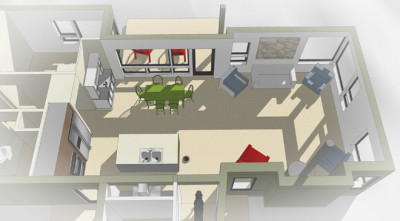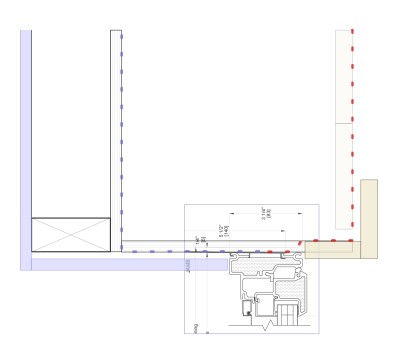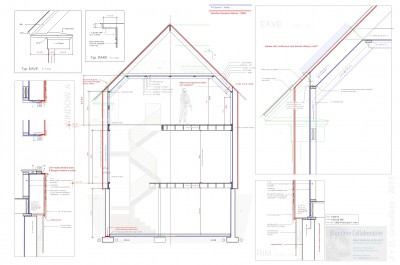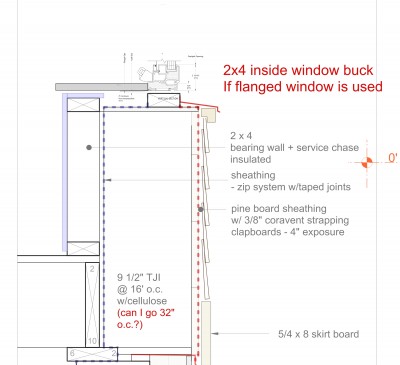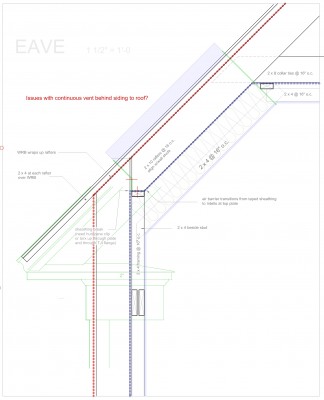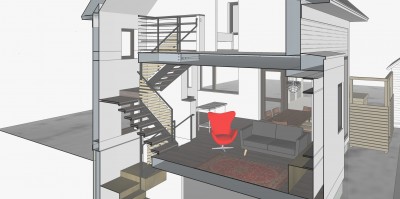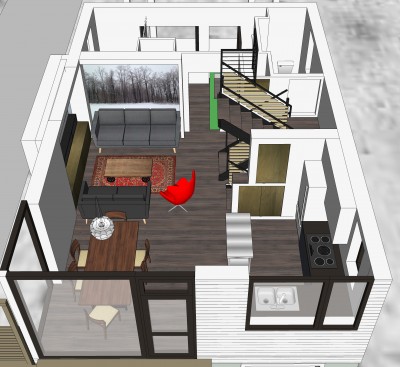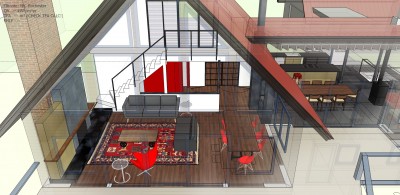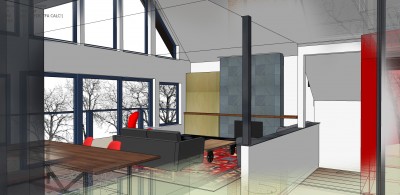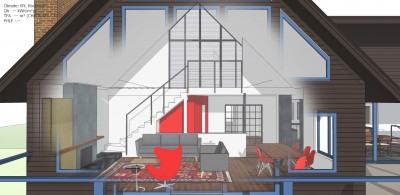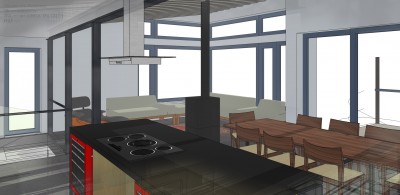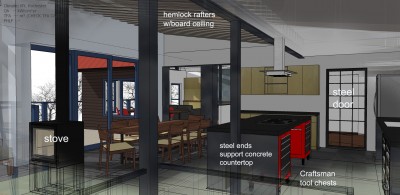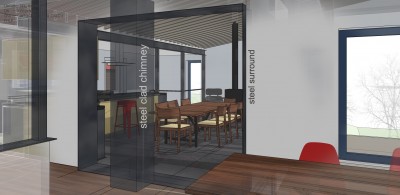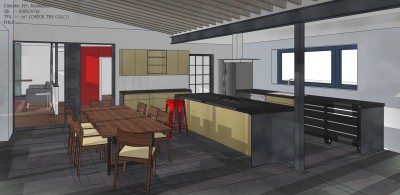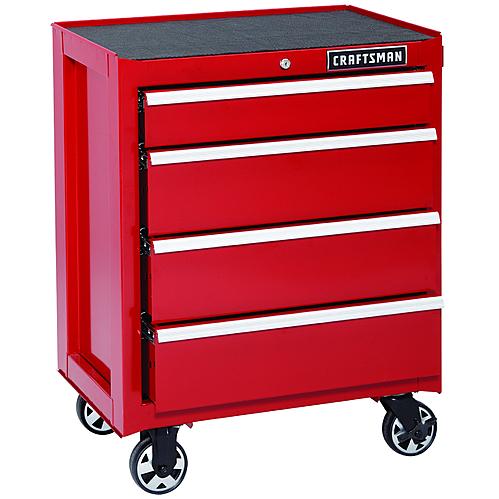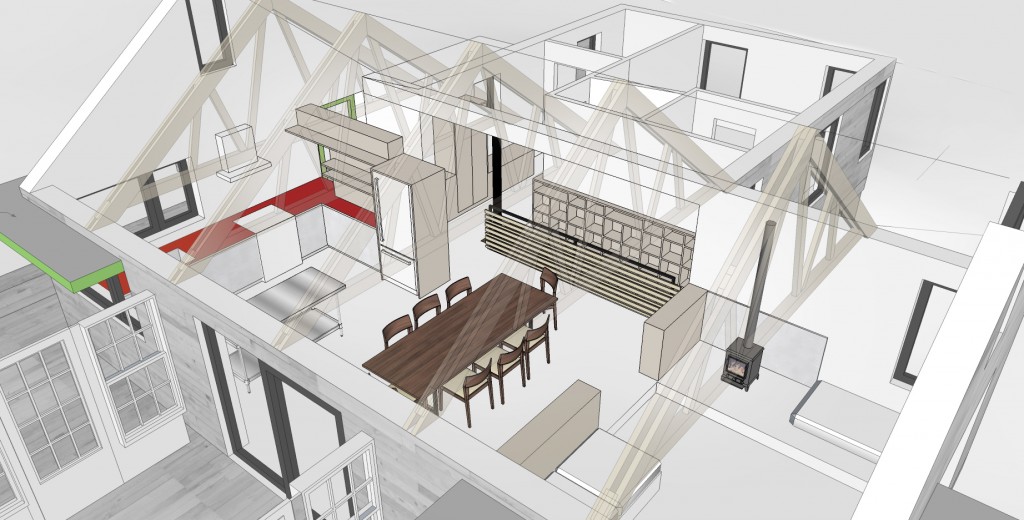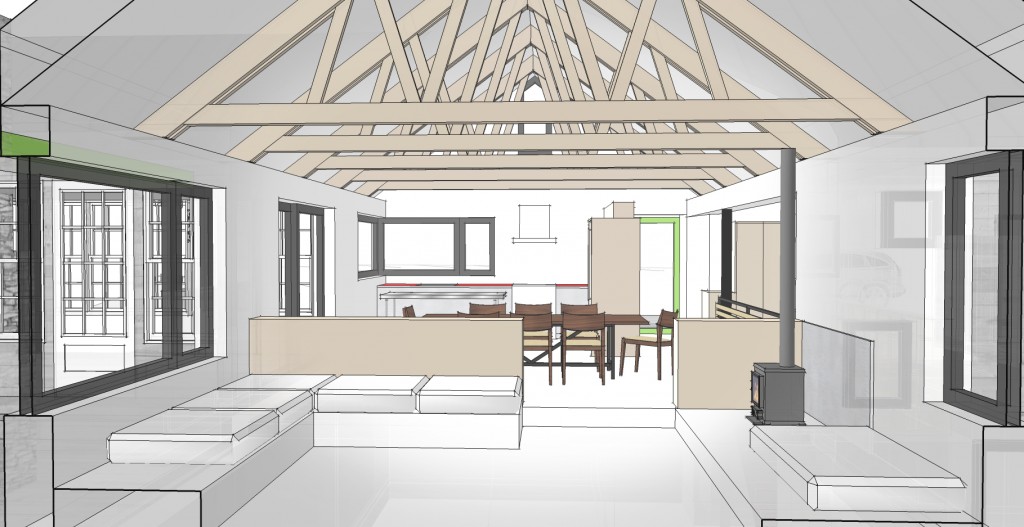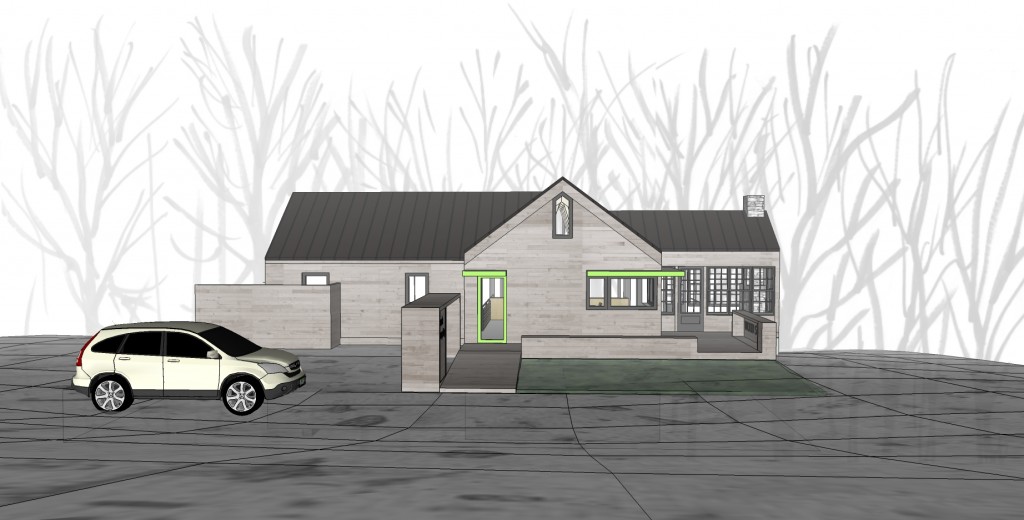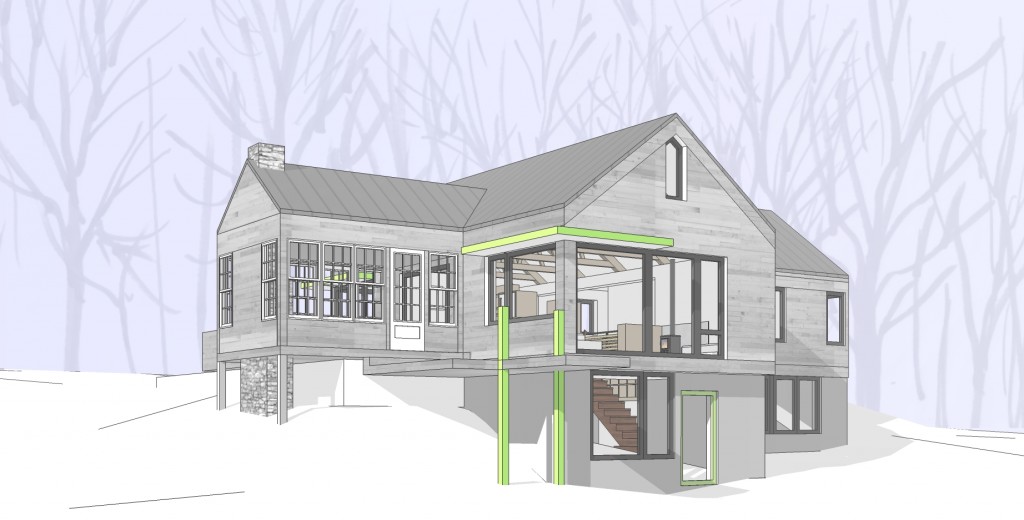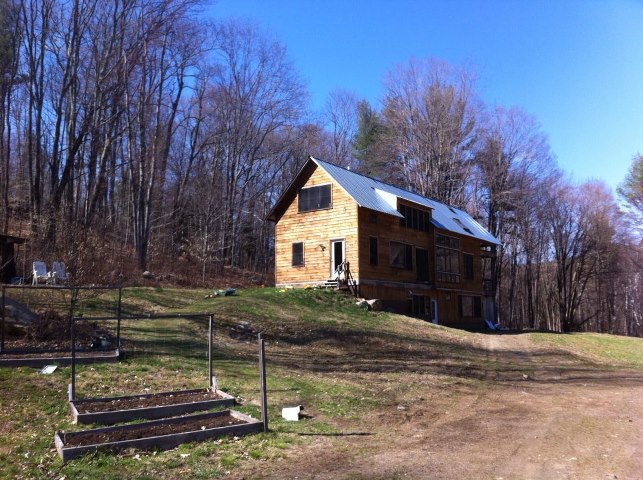I've been a bit buried lately and haven't even visited my own blog! Here is a composite view of the permit drawings for the Greenfield project (wish us luck) I try to keep drawings fairly compact and easy to use (from my days as a carpenter/builder) There are a few additional drawings for stair details not shown here because they are more of the "shop drawing" nature. There will be additional drawings detailing window and door installation as those are very tied with high performance homebuilding nowadays. In the old days you just had to specify and locate. Now it's all about how they get installed which is very different depending on which manufacturer you use. Also some details are easier to do in sketchup then import .jpgs into my CAD program and label. I never know how much or little to include. This is also a rather simple house with highly detailed high performance features. We are going for Mass tier III certification (some weird hoops to jump through there) with DEAP Energy Group consulting. Passive house certification would have been more than 10k more and this was pretty tight budget. (my in-laws). We are going to use Klearwall windows and there is an incredibly awesome steel and wood staircase design which will gain me fame and notoriety.
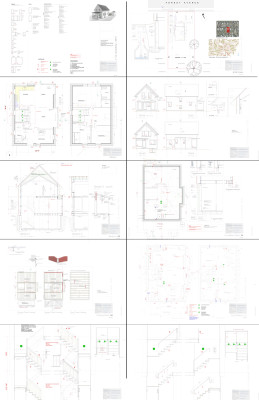
House size and ruminations Thereupon.
I am fascinated with the Tiny House Movement. Tiny House on Wheels is THOW btw. I would like to have one as guest quarters (or an airstream) but after living in a smallish (900 s.f.) house for 15 years I know that a tiny house is not for me. I do have plans to add several hundred square feet in the form of a functioning kitchen, eating area, mudroom, and a work area so I can ditch the in-town office. A THOW would have been perfect when I was young and single. I actually lived in an 8x12 cabin in the woods for 6 months sometime in the 90’s. Other than the mice and raiding raccoons, it wasn’t bad. I moved out when I started getting cold in late fall. -Pictured above Kids take up a lot of room and in our climate, you can’t just kick them outdoors to ride their bikes or do huge art or building projects. Plus each kid has to have two snowsuits, multiple winter boots, sleds, tons of books, a guinea pig (my daughter wants a cow and chickens) Not very applicable to tiny house living. Check out my friend Sean’s tiny house related blog UnBoxed House. He is building his own house using a shipping container. Although I have done a few tiny houses for clients I find I have to keep the tiny house mentality out of my regular work and attitudes, at least for now. I have found that some people are Big House People and a few (very few) are small house people. The usual conundrum comes when people have tiny house budgets but are horrified when I suggest that they need to be looking at something smaller than 1500 s.f. given their budget and their desire for quality. I once had a client who was horrified and outraged that I had designed a house with 10x12 bedrooms for her boys. (her budget was 350k) (plus she wanted a garage) Where I grew up that was a big enough bedroom for 2 boys to share. I will push and nudge and suggest like crazy but some people are just “Big House People” I have a hard time relating sometimes but I try. I nod my head sympathetically when a clients who are expecting their first child and live in a house twice the size of my own have called me in to discuss an addition to accommodate their growing family. Fine if they can afford it. I know from experience that I feel strangely uncomfortable in a house bigger than 2000 s.f. It feels wrong. Likewise a big bedroom. I contribute that to my introvert nature more than anything. I must be a medium house person. I follow a few tiny house groups on Facebook but try to ignore them mostly as people put up photos of their tiny houses that they built that, as an experienced architect, I can see that in five years, the house will be a falling apart mold factory. My face hurts too much from that sort of thing. But I applaud the do-it-yourself nature of the movement and the growing wealth of information and support.
Greenfield House - client perspective - mid design
Bob, in response to your invitation to comment on the passive house you are designing for us, here are some thoughts. I see this first of all as an opportunity to be part of the solution instead of part of the problem. The chance to show off the kind of technology and design choices that--were they widely adopted--could significantly reduce reliance on fossil fuels feels not just like an opportunity to showcase your talents as an architect but to participate in a necessary new way of thinking about housing. That you are, coincidentally, our son-in-law certainly plays a role in our enthusiasm, but it goes so far beyond providing for immediate family and grandchildren. It goes to realizing the models that are going to keep the earth inhabitable for everyone's grandchildren.
Coming back to the ground now, to the very immediate house in question and the very personal responses on an aesthetic and emotional level: It's exciting to think about having a space designed to support who we are and how we like to occupy space. The openness of most of the design, combined with the privacy of spaces designated for bedroom and in-home offices for each of us, is perfect. I imagine fondly the day when, if one of us is cooking in the kitchen and the other is in the living room, we won't have to shout to each other to be heard. I look forward to having a cup of tea by the floor-to-ceiling south-facing windows. Visual access to the outside year-round is crucial to my mental health, and if I have a view of the outside space, I need far less inside space. I am inordinately pleased by the idea that we may be able to design a root cellar into this house. The idea of storing garden vegetables connects the seasons for me. (An aside: I got a ridiculous amount of pleasure in Seattle from picking kiwi fruit in October/November, and eating it in December, January, and even February.) And, of course, those floor-to-ceiling south-facing windows will be a great spot for starting plants in the winter and early spring. Did I say I love the idea of floor-to-ceiling south-facing windows?
We love wood fires, but I've got to admit that each time I build one these days and notice the ash that has to be cleaned out and the wood dust on the rug that will need to be vacuumed I realize these are tasks I will not miss. And again, as we age, and things tend to take a little more time to accomplish just because of increased physical limitations, I won't regret leaving wood and ash hauling behind. It will leave more time for reading and writing. In the cozy office spaces or by the wonderful floor-to-ceiling windows.
Then there’s air quality and noise issues. I’m given to respiratory irritations and ailments, which means that, especially during heating season, I keep a HEPA filter running in the living room and a humidifier in the bedroom. Both are noisy, but help to create a white noise effect that drowns out traffic on the street outside. I know I’m going to enjoy the quiet of a super-insulated house and the climate-controlled clean air I’ll be breathing.
As we are very near retirement age, it pleases me that we're designing this house to be one in which we can age. Thinking ahead not to the inevitability but the possibility of one or the other of us needing a wheelchair at some point, and having the first floor bathroom at the ready, means not having to worry about retrofitting in a hurry someday.
Just knowing some of the principles of Passive House design has made me so much more aware of heat and cold. I take a hot bath, and imagine the system that will capture the heat as the water cools. I open the curtains when the sun is shining, the better to capture a bit of the free solar warmth. I have begun to use the term "thermal bridging" in casual conversation.
Circling back to the overview: I like that we are able to support, with this project, not only the concept of Passive House but also the business model that you, Mel, and Chad are using. Having presided over a remodel in Seattle, I need no convincing that it's going to be worth it to have project coordination and scheduling built in to the process and the services your team is going to provide us.
Windows - decision making process
I am grappling with window issues for several projects right now. Designing, choosing, pricing and detailing windows is much more complicated than it was as recently as 5 years ago. I used to simply specify window sizes and the builder would have the lumber yard price a few lines or a favorite manufacturer. This is still the way it is done my most builders and architects. Now we have many more options to consider with windows and this has radically affected the decision making process. In the past we didn’t look carefully at the solar gain (how much warmth from the sun gets in, visible light transmittance, U value (insulation) and especially installation detailing. With my own work, a primary goal has become to eliminate the traditional heat distribution system – boiler (oil, propane or natural gas) manifold (that thicket of valves and pipes and pumps in the basement) and distribution (radiant tubes in the floor, baseboard radiators etc) – in favor of the simplicity of an air source heat pump and often, a wood stove for alternate or backup heating. The heating system then becomes a heating appliance. This has not, for my practice, been a client driven goal but I figure I’m not doing my job if I don’t discuss these options. Most clients in recent years have simply expressed a desire to minimize fossil fuel consumption and have a house that they don’t have to worry about leaving for a few weeks in the winter. Windows are usually the biggest variable in being able to minimize and simplify the heating equipment for a building.
The process, which continues to evolve, begins with sizing and placing windows according to light, views, privacy and ventilation. So far, a fairly traditional approach. Some things effect the decisions such as whether the window opens inward, outward, up and down, sideways, or not at all. Smaller windows open easier and larger fixed pane windows are cheaper (per square foot) so we often mix and match for maximum effect. Exterior doors are often now part of the window package as well.
I use sketchup modeling for this part of design as it brings a high level of clarity at an earlier stage than any method I’ve found thus far. This is also not so traditional.
Once we have arrived at a good window configuration we need to pin down some minimum energy performance specifications. The first big decision is double glazed vs triple glazed. Double glazed windows meet energy code currently but probably won’t in a few years. Window manufacturers (in the US – in Europe they are already there) are starting to realize this and gear up to offer triple glazed window options. A largish house with small windows can probably get away with double glazed windows and meet the energy use criteria I mentioned above. I also have found that with large areas of glass, comfort becomes a big issue. It can be very unpleasant to be near a large window at night when it is zero degrees outside. Condensation issues are vastly mitigated with a triple glazed window as well. I often do some energy modeling to get a sense of what the overall heat loads of the building are. It's easy to change around the U-value to see the effect of different windows. I'm also learning how to use the sketchup plugin for the Passive House Planning Package. In my spare time. (insert smiley emoticon)
Next we look at several different options from several different window manufacturers. Unplasticized PVC (UPVC) is usually the least expensive option for any window with aluminum and fiberglass usually more expensive but offering thinner profile frames. Wood is very expensive. I’ll stay away from the PVC argument here.
With preliminary pricing in hand we – myself, the builder and the client make THE DECISION and the subset of choices that affect the price and my detailing. When these decisions are made I can put specific CAD details from the manufacturer into my drawings and create much more accurate details for how it all the windows are installed, air sealing strategies, tolerances, finish work around the windows, very specific rough opening and flashing information etc. In the past this was all fairly standard and left to the builder to figure out in the field. We don’t do it that way anymore.
the ALL -NEW Vermont Architect website and blog !
There have been some changes here spurred on by completely screwing up my blog last Friday when I hit "update" and everything disappeared. It wasn't really gone of course. But my backup copy made the day before wouldn't work. (I couldn't figure out how to make it work) Evidently, ignoring updates for too long was the underlying issue. I had been intending a complete makeover anyway, and I'm very pleased to have pulled it off. I used this template for those who are interested in that sort of thing. I am SO not a web developer but I know what I want and it seemed that I could accomplish it using this template with all its options and customization capabilities. I still have to figure out many small things that I want to adjust. Definitely view this on a big screen for maximum visual effect. It works on all screens but some of the pretty bits drop out when you start to squeeze it.
There will be a ton of portfolio stuff and drawings and models added later (major eye candy) when I get the template right for that section. I also need a section to show off the press I get.
(my intention for) The overall feel of the site a sense of transparency, light and peacefulness (introvertism?) and to express my connection to Vermont and the seasons here. The background photos are from my own land and are what I see every day.
I also intend to set up a commerce section to make it simpler to sell my stock plans and perhaps even a section for clients to log in and download updates on their projects and see/pay invoices etc. I'll probably hire someone else to set that up.
Keep checking in.
Baiser Construction Management - an intro
This is from Mel Baiser of Baiser Construction Management. I am working with her on several projects and here is what she has to say about the Greenfield project.
I have the great fortune of teaming up with Architect Bob Swinburne of Bluetime Collaborative and builder, Chad Mathrani of Vermont Natural Homes on the construction of a Passive House in Greenfield, MA. This project is incredibly exciting for a number of reasons. For a passive house certified builder (PHIUS) this is rare opportunity to be involved in the planning and construction of a home which meets the highest international building standards. As someone in my mid-thirties and the parent of a young child, I am all too aware of the climate crisis. I am also a firm believer in that bumper sticker slogan, “If you are not part of the solution, you are part of the problem.” Having dedicated over a decade to working in construction, I am committed to every effort to push this industry towards sustainability. After all, nearly 50% of the energy consumed in the U.S. can be attributed to the initial construction and operation of our buildings. Buildings that meet the Passive House standard are the buildings of tomorrow (even though we are far behind Europe and really they should be the buildings of today.)
 My company’s logo is “revolutionizing the building process” and though I may be outing myself in terms of political sympathies, my intent is to bring a new level of efficiency, organization and collaboration to the construction industry. In particular, in a high performance, net zero or passive house building, effective pre-construction planning and an integrated delivery process is essential to the success of these projects. My company offers cost planning, scheduling and project management services and I feel grateful to have found like-minded architects and builders (and clients) with whom to collaborate. I often find the traditional top down, architect driven delivery method (design, bid, build) to be antiquated, inefficient and not a suitable match for high performance building. By involving the builder, cost estimator and even the client very early on in schematic design, you can save thousands of dollars, weeks in the schedule, avoid technical errors and potential interpersonal conflict down the road.
Green building is really nothing more than a marketing tool until we make it financially and culturally accessible. Aside from achieving the Passive House standard (heating and cooling demand less than or equal to 4.75 KBtus per SF/Yr; Primary energy demand less than or equal to 38 KBtus per SF/Yr and an air leakage rate of .6 air changes per hour at 50 Pascal) our team is motivated to bring this project in on a relatively modest budget. An architect committed to building performance, budget, function and aesthetic; a contractor/project management collaborative leading local natural and high performance building efforts and a client who believes in the importance of healthy efficient homes and “you get what you pay for” is the absolute dream team for any project, but especially for this project.
My company’s logo is “revolutionizing the building process” and though I may be outing myself in terms of political sympathies, my intent is to bring a new level of efficiency, organization and collaboration to the construction industry. In particular, in a high performance, net zero or passive house building, effective pre-construction planning and an integrated delivery process is essential to the success of these projects. My company offers cost planning, scheduling and project management services and I feel grateful to have found like-minded architects and builders (and clients) with whom to collaborate. I often find the traditional top down, architect driven delivery method (design, bid, build) to be antiquated, inefficient and not a suitable match for high performance building. By involving the builder, cost estimator and even the client very early on in schematic design, you can save thousands of dollars, weeks in the schedule, avoid technical errors and potential interpersonal conflict down the road.
Green building is really nothing more than a marketing tool until we make it financially and culturally accessible. Aside from achieving the Passive House standard (heating and cooling demand less than or equal to 4.75 KBtus per SF/Yr; Primary energy demand less than or equal to 38 KBtus per SF/Yr and an air leakage rate of .6 air changes per hour at 50 Pascal) our team is motivated to bring this project in on a relatively modest budget. An architect committed to building performance, budget, function and aesthetic; a contractor/project management collaborative leading local natural and high performance building efforts and a client who believes in the importance of healthy efficient homes and “you get what you pay for” is the absolute dream team for any project, but especially for this project.
Mel Baiser Baiser Construction Management mel@baisermanagement.com
Here is an example of a project scheduling chart that Mel uses to keep everyone on track and doing their jobs in a timely fashion.
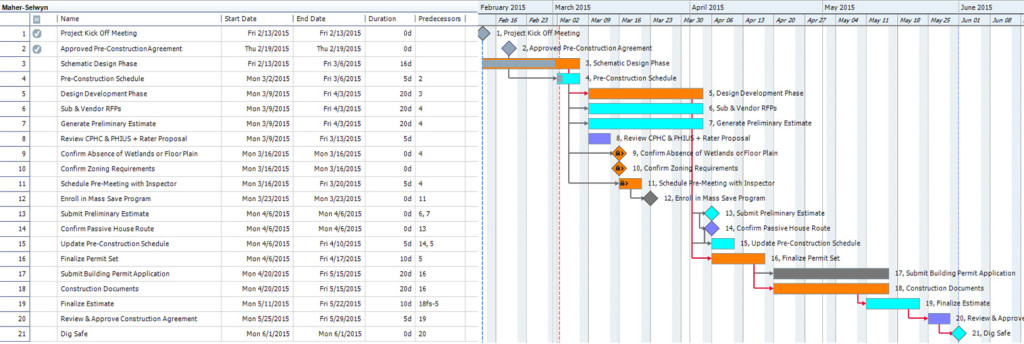
Early Thoughts on the Greenfield Project (architect)
I took a shot at writing down my own thoughts about the Greenfield project I’m doing for my wife’s folks. Sometimes I have so many half-baked ideas in my head that writing them down creates a jelling effect and helps me to clarify and focus my efforts. I’m planning on documenting this project to a much higher level than I have in the past, partly because we are assembling something of a dream team to get this done and partly because I am using this project to redefine how I work in order to bring my own practice to a higher level. I have encouraged the others to start writing as well and some of that will show up here on the blog as well for a more well-rounded perspective. We are currently exploring the feasibility of doing this house as a Passive house and seeking certification. I hope, as usual, to show what can be accomplished when a highly functional and customized plan is also an emotionally uplifting place to live. This projects continues my exploration into the emotional aspects of “home” and how to use architecture to augment and reinforce the emotional connection to place. Phew! What have I to gain from doing this project as a full-on Certified Passive House? So what if the winter heating bills drop from $75/month to $25/month? Is that really worth all the extra effort and expense to go through certification? We don’t know the answer to that yet. “Let me run some numbers” as the engineer or accountant would say. Passive house has cache. It attracts media. There is huge marketing potential. The clients (my in-laws) are understandably interested in that aspect of it - it relates to their son-in-law’s ability to financially support his wife and children. I want to do more of this type of work in the future and will I ever get such a good opportunity to gain exposure, attention and build a reputation that to do a very attractive and relevant project at this highest level… and market it to the greatest extent possible. I have seen that model propel other firms into the limelight so I am aware of what power and potential in inherent in this thinking. Otherwise- My own limited knowledge of Passive House indicated that this house as designed thus far could attain Passive House certification with minimal extra effort. I’m a Certified Passive House Designer – CPHD with the international credential but I have little practical experience. This project could be a great way to gain that experience. The most effort and extra money will probably be in soft costs – hiring someone with experience to do the energy modeling, advise on detailing and assist in the certification process. With this project we are also formalizing a fairly progressive project delivery process that I am realizing is crucial to creating high performance buildings. This represents the direction my own business model is headed in. I have, in the past, followed both the more traditional architect route where I work with clients to design and detail a project and we shop it out to builders. I have also worked (more often) in a more design-build model where the builder is integrated into the process from very early in the process. That has been my preferred method of project delivery but I am realizing that to provide the highest levels of service, I need to fill in some gaps. I can’t do everything and I don’t have expertise in everything so I’m bringing in people to help fill the traditional gaps. Subcontractors as well need to be on board as part of the team at a much earlier stage and need to be aware that they will be asked to perform at a very high level of professionalism. Part of my job is to make that as easy as possible for them through design and detailing. I am working on this project with Mel Baiser of Baiser Construction Management and Chad Mathrani of Vermont Natural Homes both of whom have training in passive house detailing and construction. They understand what it takes to reach that highest level of building excellence. And considerable enthusiasm to do so. We are pouring over the details as fast as I can draw them up to insure that no stone is left unturned. The process requires a high level of integration at this early stage in terms of product selection, integrated assembly, cost (and relative costs). Assumptions are challenged and vetted and everything will be put down on paper before the project is staked out on the site which is under considerable snow at the moment. We will maintain a process blog as part of Vermont Architect to provide a window into this process. Blog readers and Bluetime Collaborative facebook followers have already seen some early schematic design images of this project. Stay tuned.
Portit mollis vitae
Nullam ornare, sem in malesuada sagittis, quam sapien ornare massa, id pulvinar quam augue vel orci. Praesent leo orci, cursus ac malesuada et, sollicitudin eu erat. Pellentesque ornare mi vitae sem consequat ac bibendum neque adipiscing. Donec tellus nunc, tincidunt sed faucibus a, mattis eget purus. Nunc ipsum orci, consectetur in euismod id, adipiscing nec libero. Vivamus sed nisi quam. Donec id arcu non libero pellentesque condimentum at in mauris. Duis et lacus lectus, eu aliquet tortor. Maecenas cursus consectetur tellus non lobortis. Donec sed arcu a justo cursus varius ut et diam. Suspendisse lobortis pulvinar velit, id convallis eros pulvinar ac. Cras a lorem lorem, et feugiat leo. Nunc vestibulum venenatis est nec tempor. Nunc mattis sem in mauris posuere aliquam.
From the archives - Grumpy architect time
From the archives - Grumpy architect time: 1.If your house is adequately insulated there should be little temperature differential between the ceiling and the floor. 2. Adequately differs from code. Remember, a house built to code is the worst house you can legally build. 3. If you choose not to build an Energy Star certified home please give your poor starving architect the $2k that you obviously have to spare. 4. Does anybody with any real knowledge of building use fiberglass batts anymore? probably not anyone who reads this. 5. Air sealing folks! do it correctly!- not 6 mil poly vapor barrier - that was the 90's We are SO over that. There are some great products and great information is available. Check out 475 supply and Green Building Advisor. 6. Why do people want to build a super-insulated house and then put a full on radiant floor heating system in? - see #3 above about where to send all that extra money. 7. Why do people want to build a new house that looks old? I think it's just a phase this country is in. I see signs that the retro-anachronistic architecture phase is fading. 8. But I do it anyway - gotta feed the family + I enjoy it. Sometimes. 9. Bright side - the science of how to build correctly is settling out in favor of simplicity. That is what draws me to the Passive house approach. 10. Why do people have SO MUCH STUFF? 11. How did it happen that I'm going to my 20th year architecture school reunion tomorrow? - footnote: this was the summer before last and it was a blast!
Always know what and where your AIR BARRIER is.
I’m working on detailing out a smallish house in Greenfield, MA. We probably won’t go full Passive House on this but we will look at what additional costs and detailing it would take. And if we’re close…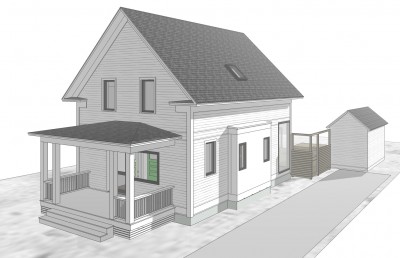 We are doing some novel (to me) stuff for the shell of the house that, I suspect, will become more standard practice for me in years to come.
Here are some “progress print” detail drawings from the plan set. My drawings tend to look a bit different than most architect's drawings due to two things: The time I spent wielding a hammer and trying to interpret my own drawings and the fact that I have worked as a sole practitioner for so long and have developed my own graphic style. I should add to that a third thing – my knowledge of building science informed best practices.
We are doing some novel (to me) stuff for the shell of the house that, I suspect, will become more standard practice for me in years to come.
Here are some “progress print” detail drawings from the plan set. My drawings tend to look a bit different than most architect's drawings due to two things: The time I spent wielding a hammer and trying to interpret my own drawings and the fact that I have worked as a sole practitioner for so long and have developed my own graphic style. I should add to that a third thing – my knowledge of building science informed best practices.
The first thing you will notice about these drawings is actually the most important thing. The red and blue dotted lines represent the weather resistant barrier and the air barrier respectively. If your drawings don’t have at least the air barrier called out in the sections, (and continuous around the thermal envelope) The drawings are incomplete. I have been getting picky in my detailing about how to make the air barrier both easy to achieve and durable. In my opinion, relying on painted sheetrock to serve as an air barrier just doesn’t cut it – certainly not for the next 100 years.
Many builders and architects in the Northeast US are still building 2x6 walls with fiberglass batts and a poly vapor barrier. That’s how I learned to do it when I was just starting out in the 90’s. I also opened up a number of walls built that way that were full of mold.
-
Good
builders don’t build this way anymore. Check the Building Science Corporation website for some pictures of what can go wrong.
One part of building science is probability and statistics. I often hear builders say “I’ve always built that way and I’ve never had any problems” - that you know about. But those builders are only looking at 50 or 100 projects. Luck plays a part here. What happens when you look at thousands or even tens of thousands? You start to see some patterns emerge and you start to see the luck factor drop out of the equation. You are able to formulate some best practice standards for a number of things including durability, air quality, energy use and even catastrophic failure. I prefer to work with builders who are informed about building science and involved in the discussion.
That’s easy here in the Southeastern Vermont area home of Building Green area, home of Building Green and SEON which sponsors a well-attended monthly building science discussion group and learning circle. – If anyone wants to get something like this started in their own community, send Guy an email at the address in their website.
I owe it to my clients to help them get the best constructed project possible. That, in addition to the most functional, aesthetically appropriate, finely crafted project possible.
– Oh and the budget thing too –
Detailing such as represented in these drawings is also very much about budget. The goal is to bump up the levels of insulation, air tightness, r value of windows etc. so that we can eliminate the traditional boiler and heat distribution system in favor of a minisplit heat pump which is more of an appliance than a system and dramatically less expensive. (I think this link is a GBA pro only link - subscription) For those without a subscription try this alternative Ideally, it becomes a wash cost wise but with the added bonus of very low monthly heating and cooling costs. Those savings alone can represent hundreds of dollars per month.
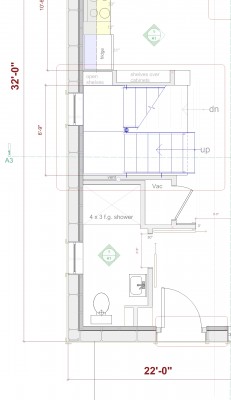
A Smallish House in Massachusetts
I am working on a 1400 s.f house in Massachusetts. Given that the walls are over a foot thick, the actual square footage is quite a bit less (about 1200). The extra insulation (and cutting edge building science) allows us to forgo a heat system other than a relatively inexpensive minisplit - and monthly fuel bills. Here are a few images of what I'm up to. no fancy rendering for now, just the Sketchup model and some Vectorworks CAD drawings.
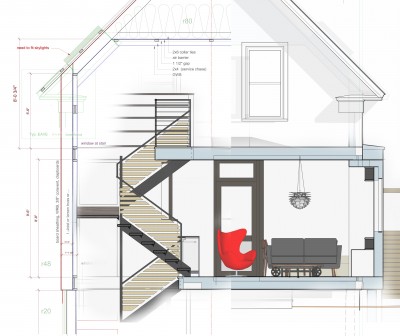
I spent a fair amount of time detailing the steel and wood stairs in Sketchup as I have found that is the only way for me to really figure out every nut and bolt and refine the design to the level that I am comfortable with before construction drawings. I like to approach the stair as sculpture with every piece exact and connections "just so". Thus I am able to design something that is quick and easy to assemble with just the right amount of "fudge space" built in.
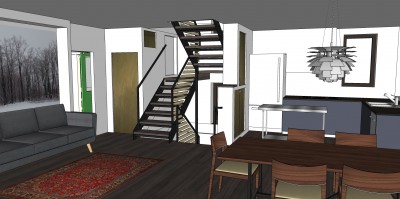
The floor plans have shrunk and simplified from the last version becoming more functional and comfortable.
Perry Road House photos
Some photos from the Perry Road project which is sitting empty and unfinished and for sale UPDATE: SOLD!- (It's hard for people to earn a living around here so the owners made the decision to move to where they could work.. for money)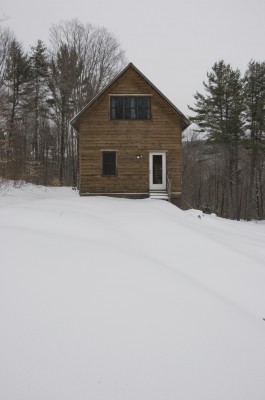
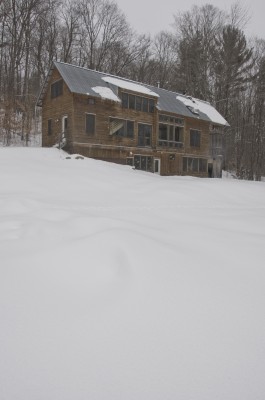
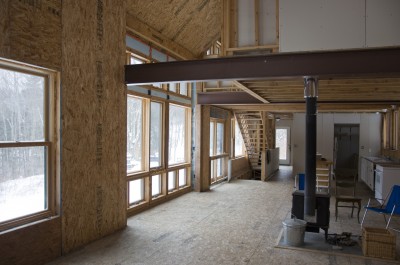
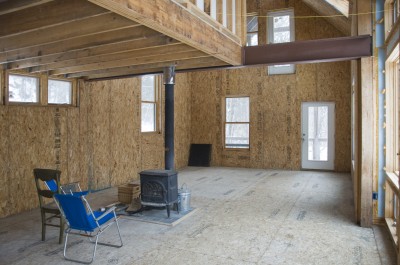
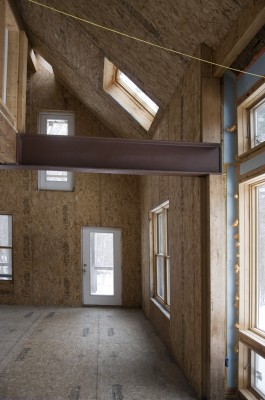
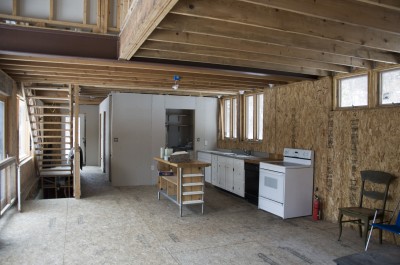
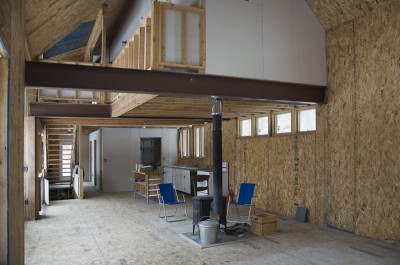
This is a Structural Insulated Panel (SIP)house on and Insulated Concrete Form foundation (ICF) The windows are Marvin Integrity - there are a lot of them although they seem all very logical and needed. Too bad they are not triple glazed. The basement slab is piped for radiant heat, there is an air exchange system, two bathrooms, (plumbed for a third) up to 5 bedrooms, porch and sleeping porch. There is also a lot of land with a stream and waterfall.
Mod Ski Home in VT - interiors
I'm working on fleshing out the interiors for this addition renovation project here in Vermont.
G-Jan-4 from Robert Swinburne on Vimeo.
Old Fashioned Stoves in New England
I grew up in Maine with a large wood cookstove similar to this one. Cooking in it was sketchy and it was far from tight or efficient. The top surface and oven provided excellent places to keep pies and already cooked food warm on Thanksgiving. My own home has a small efficient and relatively airtight woodstove tucked into the stone fireplace. It has a knurled top surface which makes it hard to even heat water on but it does a good job of heating the house and the front is a large widow so we can watch the wood burn. (nice) We used to have an old fashioned parlor stove but it was too big and inefficient (and a bit scary when it ran hot) It now sits in the barn awaiting installation out there for use during barn parties. Here is what it looked like in place:
Cooking in it was sketchy and it was far from tight or efficient. The top surface and oven provided excellent places to keep pies and already cooked food warm on Thanksgiving. My own home has a small efficient and relatively airtight woodstove tucked into the stone fireplace. It has a knurled top surface which makes it hard to even heat water on but it does a good job of heating the house and the front is a large widow so we can watch the wood burn. (nice) We used to have an old fashioned parlor stove but it was too big and inefficient (and a bit scary when it ran hot) It now sits in the barn awaiting installation out there for use during barn parties. Here is what it looked like in place:
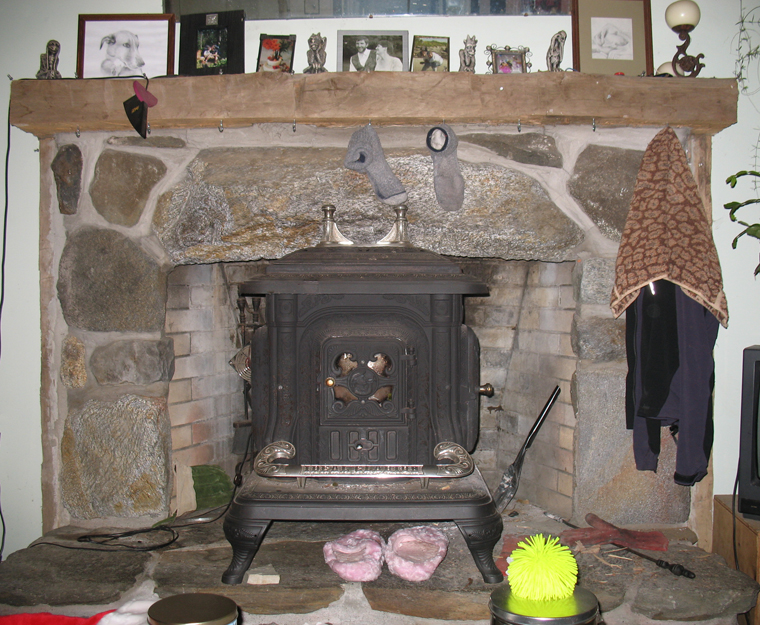 Please ignore the pink fuzzy slippers and yellow koosh ball. And the socks...
I would love to have a spot in my home for a modern wood cookstove such as this:
Please ignore the pink fuzzy slippers and yellow koosh ball. And the socks...
I would love to have a spot in my home for a modern wood cookstove such as this:

Here are some places in New England that restore and sell antique wood stoves.
Once Upon a Time Antique Stove Shop in Vermont. VPR recently did a story on them HERE
Good Time Stove Co. in Massachusetts
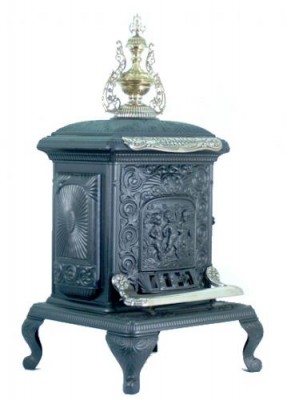
Bryant Stove and Music in Thorndike ME
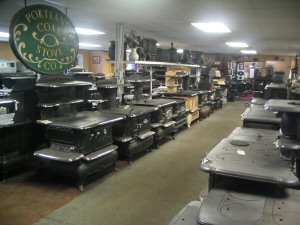 I purchased my own parlor stove from this place and it is truly amazing. there are not only hundreds of stoves but an antiques museum and a huge room packed full of dolls and gizmos that, when you flip the switch upon entering all erupt into action including merry go rounds, dancing dolls, teddies on airplanes, circus bands....I can't really describe it well. Here is a Boston.com article that does a better job and an image from their article
I purchased my own parlor stove from this place and it is truly amazing. there are not only hundreds of stoves but an antiques museum and a huge room packed full of dolls and gizmos that, when you flip the switch upon entering all erupt into action including merry go rounds, dancing dolls, teddies on airplanes, circus bands....I can't really describe it well. Here is a Boston.com article that does a better job and an image from their article
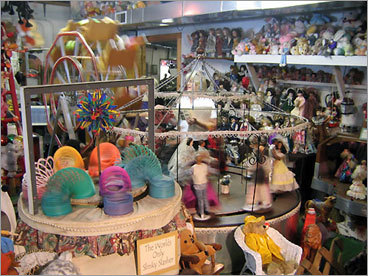 did I mention Slinkys?
did I mention Slinkys?
Education of an Architect('s wife)
The Day I Became a Modernist—Guest Post by the Architect's Wife There was a time in my life when I would not have uttered the word “modernist” without an accompanying sneer. My aesthetic tastes then ran toward the…dilapidated. If it was old with a sagging roof, I liked it. Bonus points if it looked like it might fall over any minute. I loved dark little stone cottages that probably had little light and abundant mildew inside.
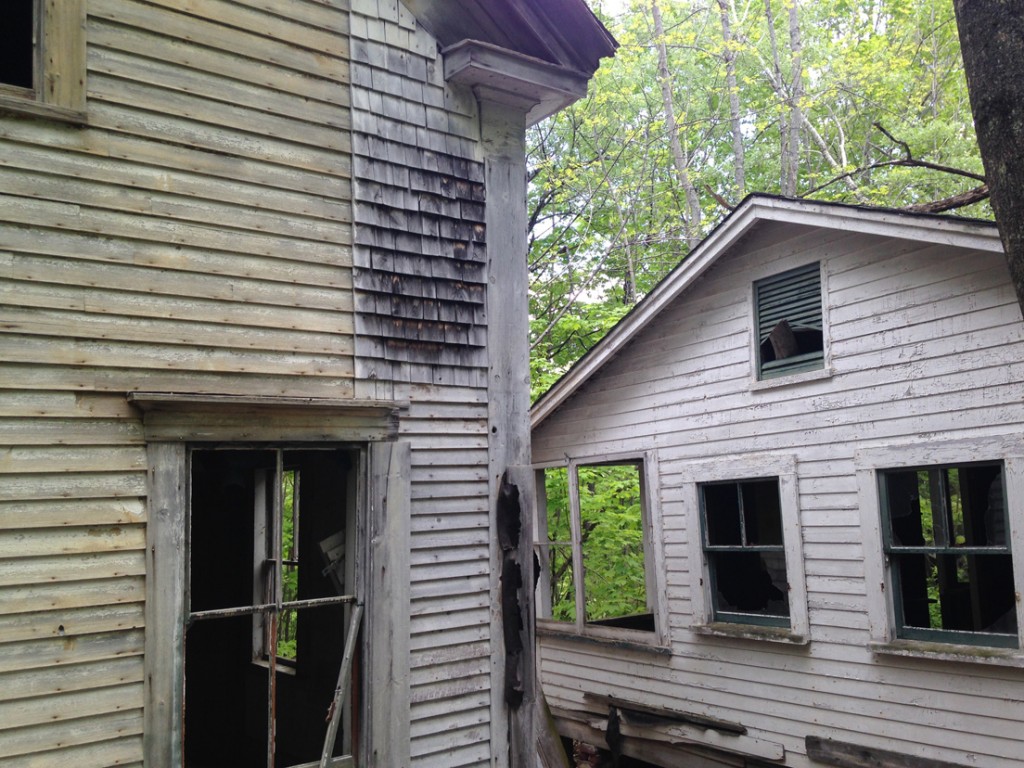 No Bob - maybe more like this:
No Bob - maybe more like this:
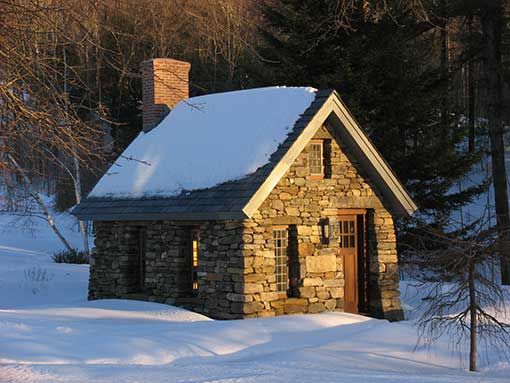 but crappier - ed.
but crappier - ed.
When I was a child visiting my grandparents in Chicago, I was bored to tears by the Frank Lloyd Wright tour.
Then I met Bob. Who will describe how he was moved to tears the first time he saw Falling Water.
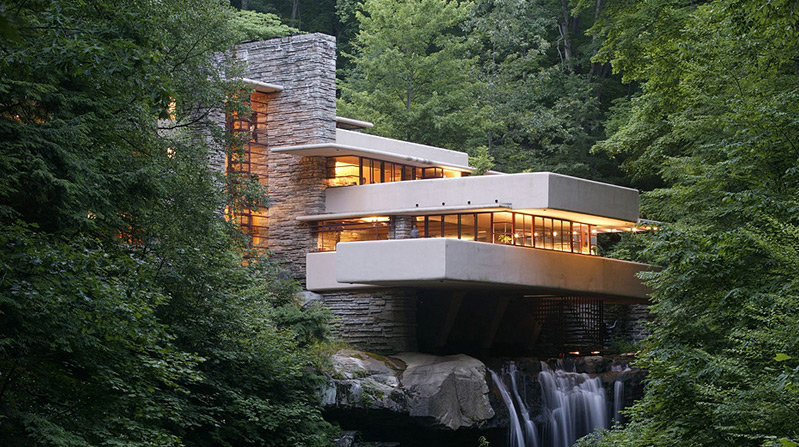
Gradually, from listening to him talk I began to be more open-minded. I realized that much of what I had derided was not actually modernist, but rather the post-modern stucco’d bland that was the hallmark of the late ‘80s gentrification during my teenage years in Seattle. Under Bob’s tutelage, I developed an appreciation for the concept of modernism as something that embraced clean simplicity, elegance in minimalism, form in the service of function. But I still didn’t really like it.
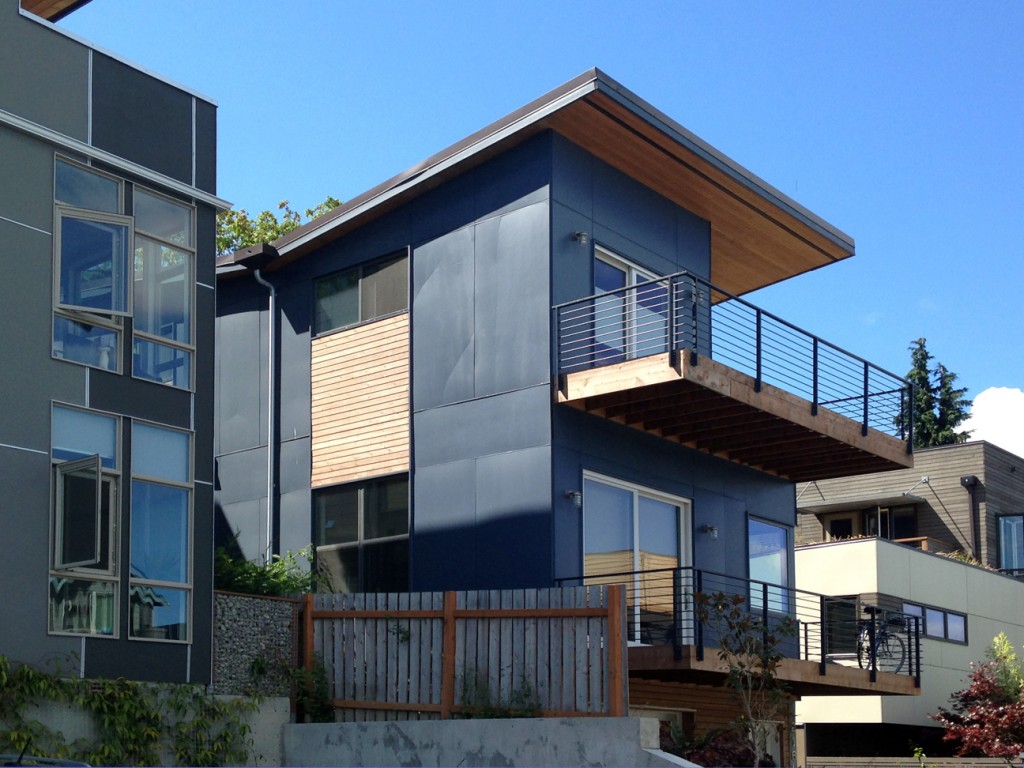
The other thing for which Bob helped me develop an appreciation was bicycling. I had not owned a bike since the one I had at age 8 that had pedal brakes and a coveted banana seat. But since he was an avid cyclist, I got a basic mountain bike and began learning some technical skills for riding the trails. I loved riding but rolled my eyes when he would wax eloquent about sleek steel or clean joints or carbon fiber. To Bob, a well-made bicycle is a work of art.
About a year and a half into our dating, Bob and I took a trip out West to Seattle (my childhood home), Portland and Northern California. Since one of Bob’s favorite pastimes was (is) visiting bike shops to ogle the merchandise, we stopped at a large shop in Portland. After forty minutes or so I was feeling glazed and wandered to a different part of the shop.
And there, at the end of an aisle, I saw it. It was titanium. It was sleek. It was retro. For the first time, I could understand the urge to hang a bicycle above the mantle. The angels were still singing when Bob found me staring slack-jawed at the Merlin Newsboy. If I recall, he nodded patiently with a knowing smile as I sputtered about how beautiful and perfect it was. That Christmas, he got me a Merlin decal as a joke (the actual bicycle was a limited edition with a price tag something on the order of $3500, and didn’t come in my size frame anyway).
By the following Christmas after that, we had gotten married and bought our home together. Browsing through the tool department at Sears, the angels sang for me a second time. Bright red, ball-bearing Craftsman cabinets. Those drawers feel downright sexy, how smoothly they open and close. Open-close, open-close I went as Bob looked at table saws or something. And all I could think was : kitchen utensils!!
So I guess that sort of clinched me as a modernist. And I even like the buildings now, too (I challenge anyone to not love weathered core-ten steel cladding).

I suppose fifteen years of living with Bob has rubbed off on me. But I still love dilapidated, too.
Scandinavian influence in Vermont
AmesHill October29 from Robert Swinburne on Vimeo.
This one will have a bit of a rustic Scandinavian feel to it. And be super-insulated of course.
Progress on Mod ski home in Vermont
One of the projects I'm working on is an addition to and renovations of a ski home in Vermont. The main house is well built and and other than a maroon and pink bathroom and rather 80's finishes, we are not doing anything too major to it.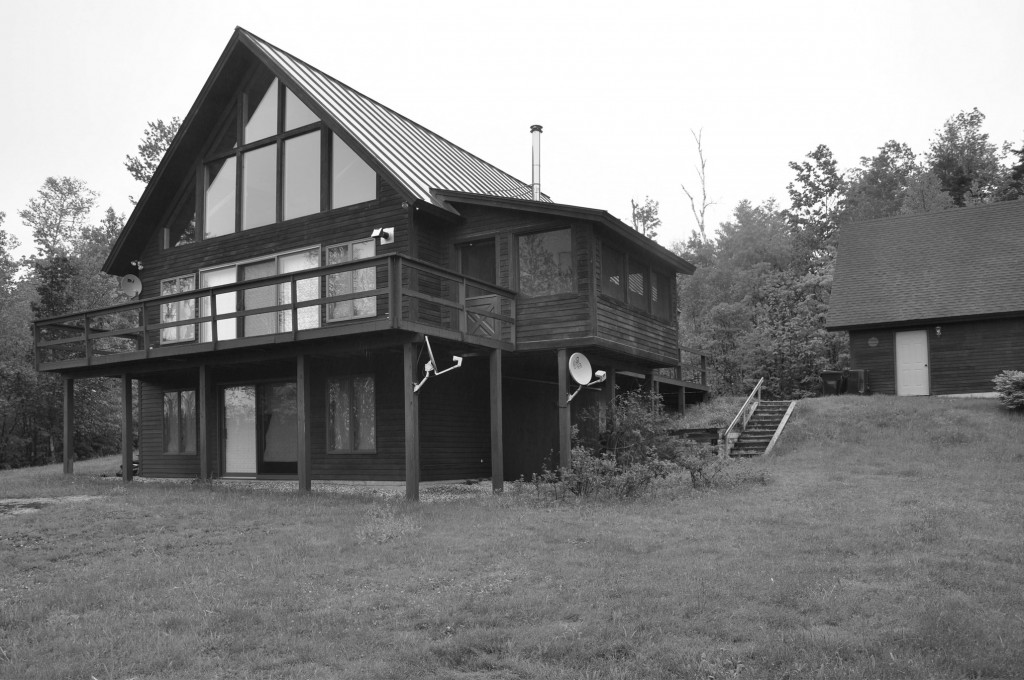 We are locating a family room addition between the existing house and garage which will provide a much nicer kitchen and living area plus additional bunkrooms and a multi-user bath on the basement level. I'm sticking with the dark clapboard and red standing seam roof of the existing as I think it provides a nice base for some fun things to happen with color at the doors and windows.
We are locating a family room addition between the existing house and garage which will provide a much nicer kitchen and living area plus additional bunkrooms and a multi-user bath on the basement level. I'm sticking with the dark clapboard and red standing seam roof of the existing as I think it provides a nice base for some fun things to happen with color at the doors and windows.
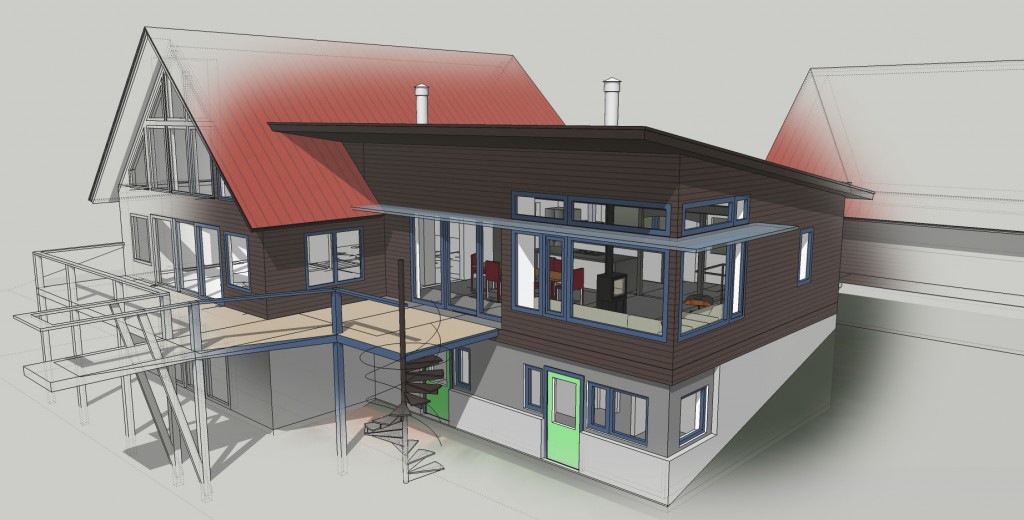
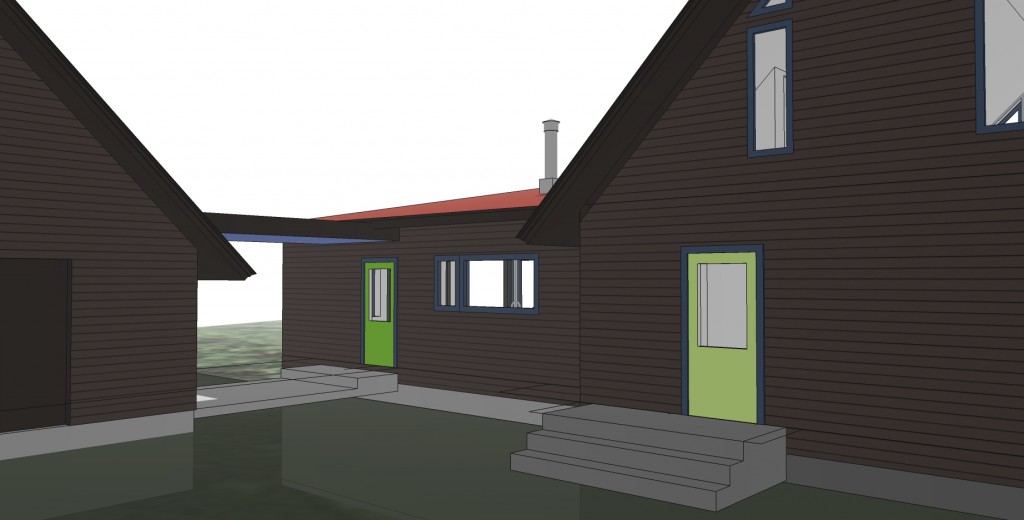
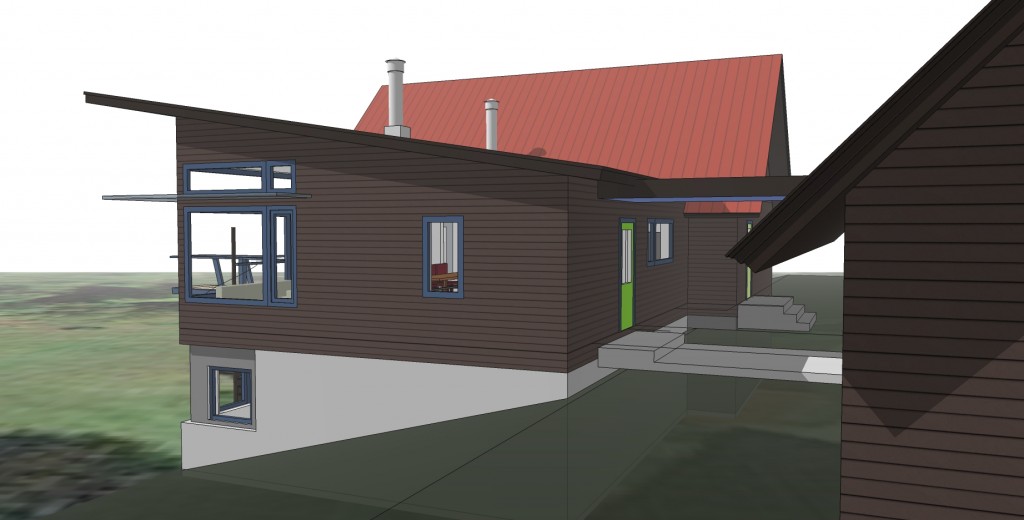
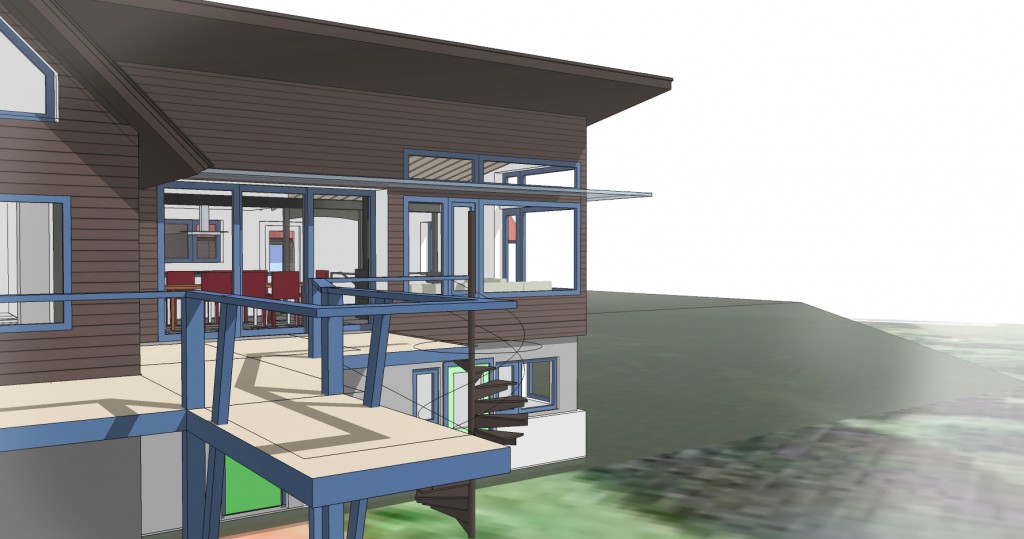
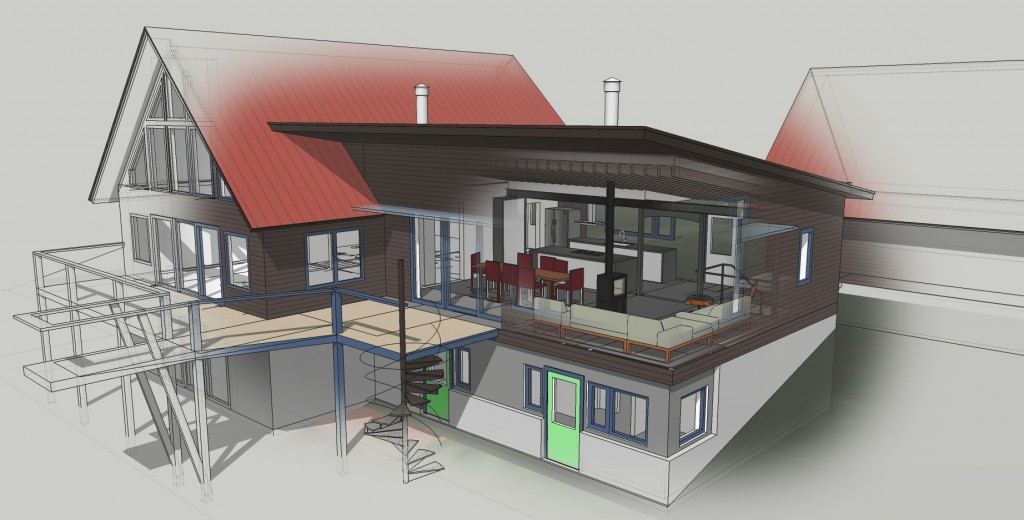 I am using big windows, wood, steel etc to create a warm, modern and relaxed space for lots of people to be in.
I am using big windows, wood, steel etc to create a warm, modern and relaxed space for lots of people to be in.
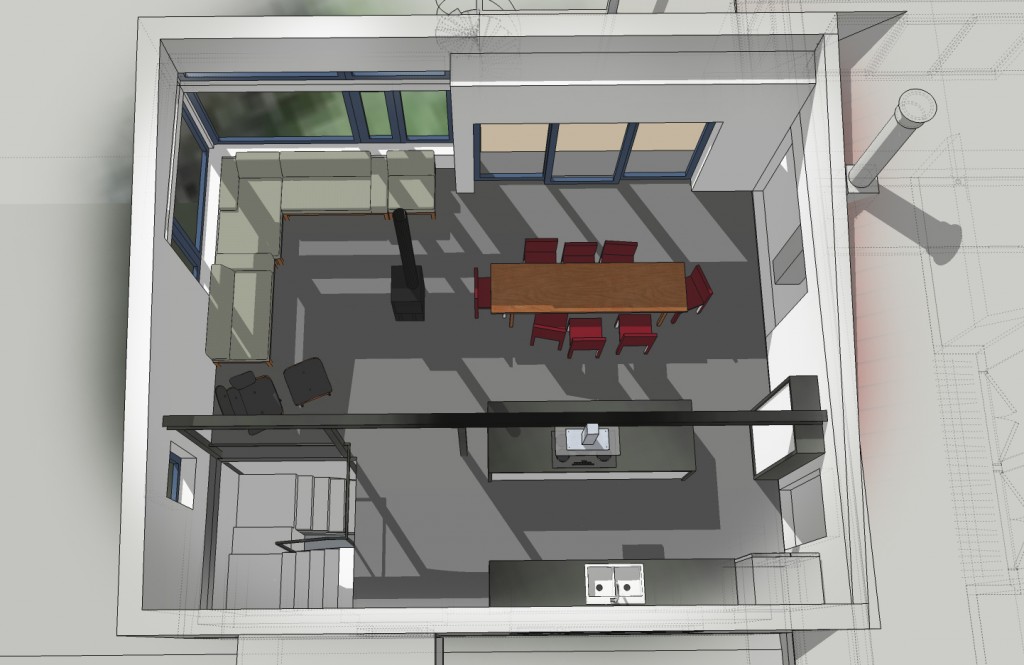
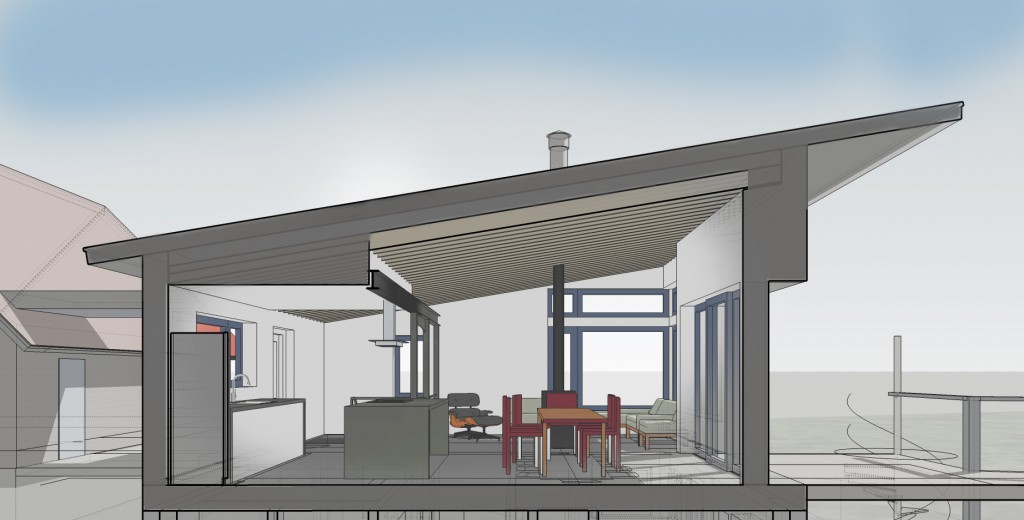 Here is the current plan:
Here is the current plan:
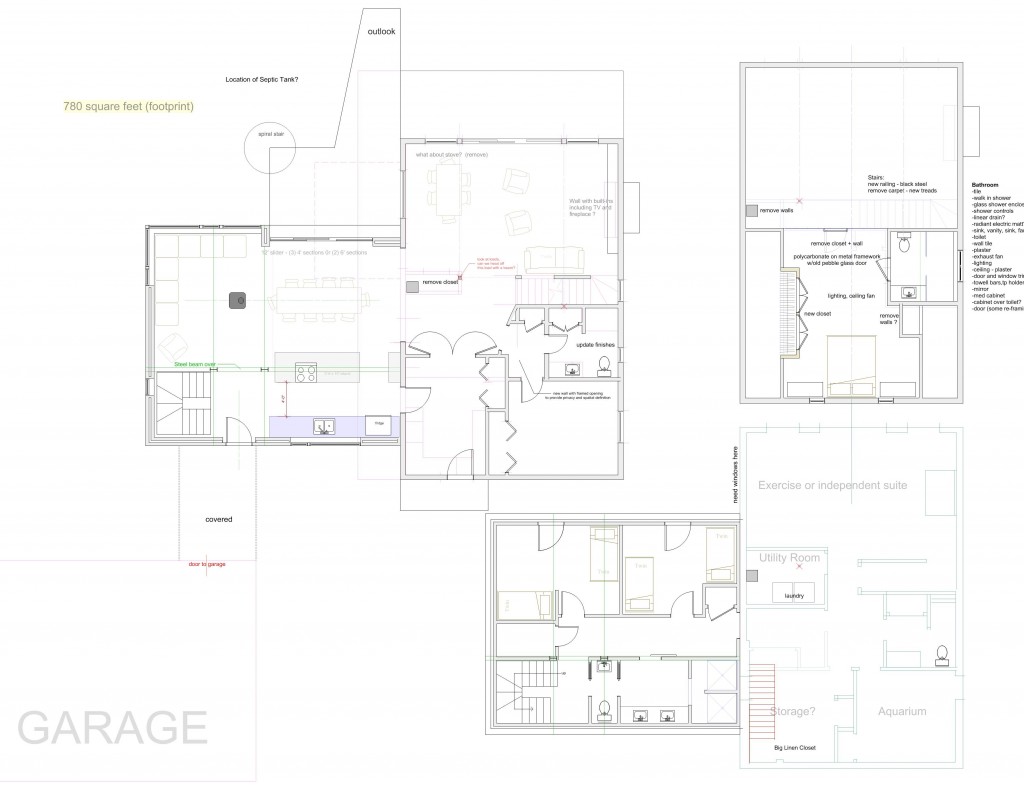 and I put together a few videos of the sketchup model
and I put together a few videos of the sketchup model
Perry Road Realtor Listing
Tiny House Infographic from CustomMade
I was just emailed a link to this really excellent tiny house infographic and it seemed worth sharing. I would add to this the community building aspects of the tiny house movement.
Less Is More:The Tiny House Movement
Infographic by CustomMade
D2R2 2014
 I just registered for D2R2 - The Deerfield Dirt Road Randonnee Next Saturday. Will I see any of you there?
I just registered for D2R2 - The Deerfield Dirt Road Randonnee Next Saturday. Will I see any of you there?

